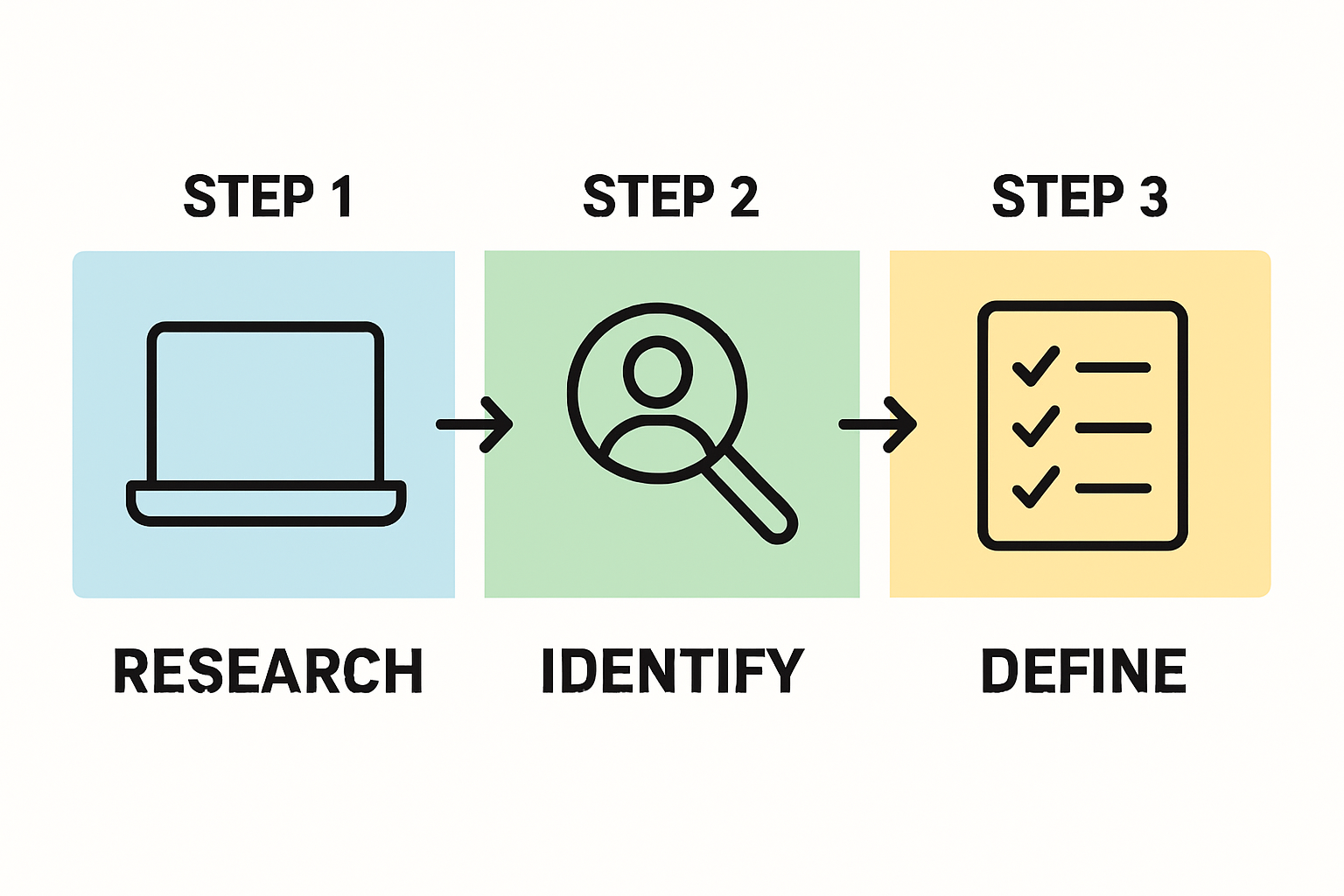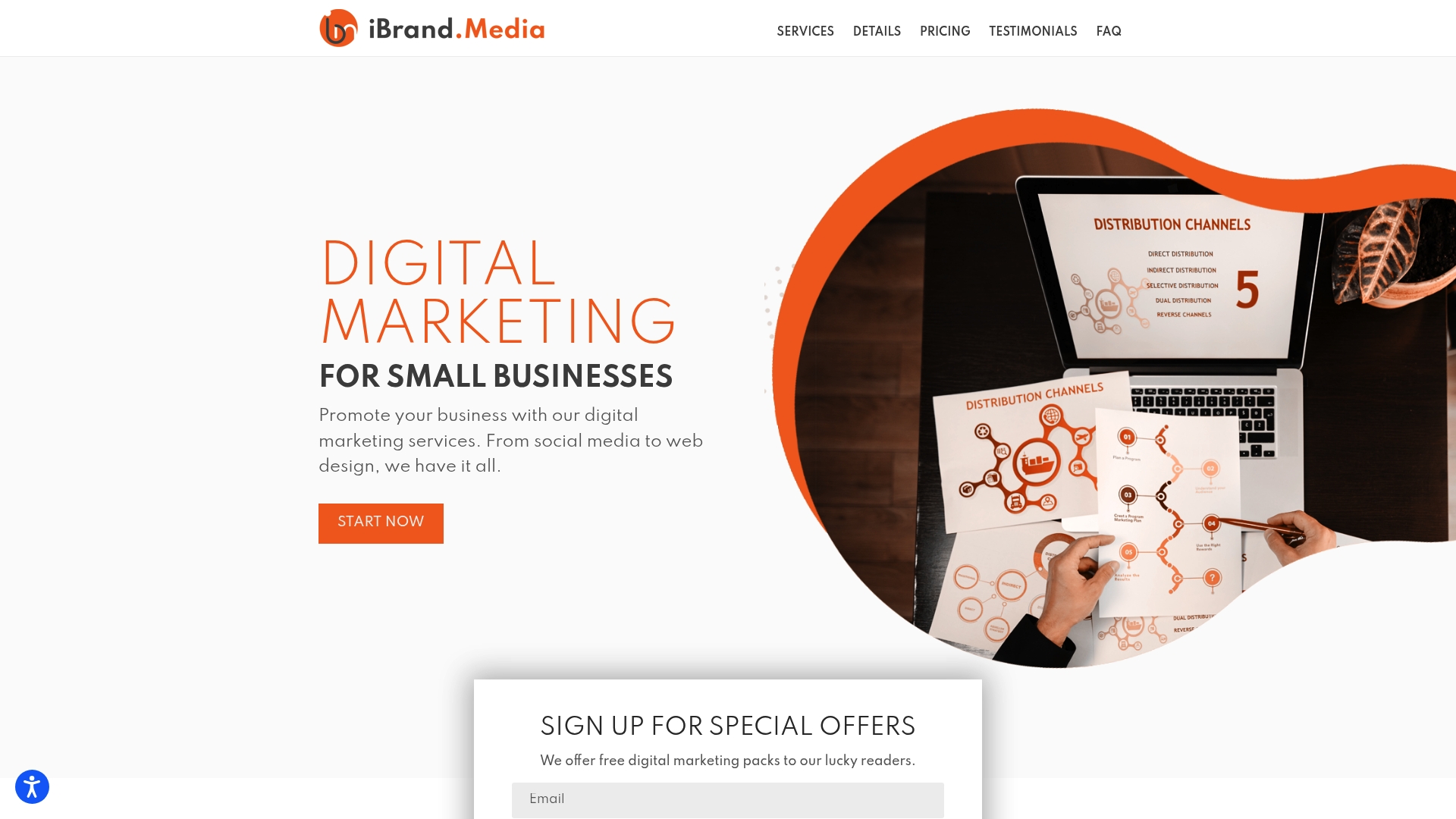Finding ways to engage customers online can feel overwhelming when choices seem endless and attention spans are shrinking. Only businesses with a laser-focused customer profile see real results. Most people think it’s all about clever ads or viral tricks. The truth is lasting engagement starts by truly understanding who your audience is and speaking directly to what they care about most.
Table of Contents
- Step 1: Define Your Target Audience
- Step 2: Create Compelling Content
- Step 3: Choose the Right Online Platforms
- Step 4: Implement Interactive Engagement Strategies
- Step 5: Measure Engagement and Adjust Tactics
Quick Summary
| Key Point | Explanation |
|---|---|
| 1. Define your target audience clearly | Engage in thorough research to understand demographics, behaviors, and needs of potential customers. |
| 2. Create compelling and authentic content | Use storytelling techniques to connect emotionally with your audience and address their specific challenges. |
| 3. Select platforms that match preferences | Align your online presence with where your target audience spends their time for effective engagement. |
| 4. Implement interactive engagement strategies | Encourage two-way communication through polls, Q&As, and live chats to foster connections with customers. |
| 5. Continuously measure and adjust tactics | Use analytics to track engagement metrics, identify trends, and refine strategies based on customer interactions. |
Step 1: Define Your Target Audience
Engaging customers online starts with understanding exactly who they are. Knowing your target audience is the critical foundation for any successful digital marketing strategy. Without a clear picture of your ideal customer, your online efforts will feel scattered and ineffective.
Starting this process requires deep research into your potential customers’ demographics, behaviors, and specific needs. You want to move beyond generic descriptions and develop a laser-focused customer profile that reveals precise motivations and pain points. Consider characteristics like age range, income level, professional background, lifestyle preferences, and digital consumption habits.
Mapping Customer Personas
Creating detailed customer personas transforms abstract demographics into living, breathing representations of your ideal clients. Begin by collecting data through surveys, social media insights, website analytics, and direct customer interactions. Look for patterns in how different customer segments engage with your brand online. Are they professionals seeking quick solutions? Young entrepreneurs craving innovative services? Understanding these nuances helps craft messaging that resonates authentically.
Practical tools can streamline this research process. Google Analytics provides comprehensive demographic insights about website visitors. Social media platforms like Facebook and LinkedIn offer robust audience segmentation tools that reveal intricate details about potential customer groups. By combining multiple data sources, you’ll develop a multidimensional understanding of who your customers truly are.
Verify your target audience definition by asking these critical questions:
- Can you describe your ideal customer in vivid, specific detail?
- Do you understand their primary challenges and aspirations?
- Have you mapped out their typical online behavior and preferred communication channels?
Mastering audience definition isn’t just about collecting data – it’s about developing genuine empathy and understanding. The more precisely you can articulate your target audience’s needs, the more effectively you can design online engagement strategies that feel personal and compelling.
Here is a checklist table to help you verify whether you have clearly defined your target audience before moving to the next step.
| Verification Question | What to Look For |
|---|---|
| Can you describe your ideal customer in vivid, specific detail? | Detailed descriptions including demographics, motivations, and pain points |
| Do you understand their primary challenges and aspirations? | Clear list of obstacles and goals that matter to your audience |
| Have you mapped out their typical online behavior and preferred communication channels? | Insight into digital habits, preferred platforms, and communication styles |
| Have you collected data from multiple sources? | Use of surveys, analytics, and direct interactions to build personas |
| Can you empathize with their needs and experiences? | Ability to articulate problems and solutions from the customer perspective |

Step 2: Create Compelling Content
With a clear understanding of your target audience, the next crucial step is crafting content that truly resonates and captures their attention. Compelling content is not just about information – it’s about creating an emotional connection that transforms casual browsers into engaged customers.
Developing powerful content requires a strategic approach that goes beyond surface-level descriptions. You need to speak directly to your audience’s core desires, challenges, and aspirations. This means diving deep into storytelling techniques that make your message memorable and impactful. Think about how you can solve problems, answer questions, or provide unique insights that your target audience craves.
Storytelling and Authenticity
Your content strategy should prioritize authenticity and genuine value. According to research from Iowa State University, storytelling that cultivates emotional connections dramatically increases audience engagement. This means moving beyond dry facts and creating narratives that feel personal and relevant. Share real experiences, customer success stories, or behind-the-scenes glimpses that humanize your brand.
Consider leveraging multiple content formats to keep your approach dynamic. Written blog posts, engaging videos, informative infographics, and interactive social media content can help you reach different segments of your audience. The key is consistency in messaging and quality. Each piece of content should feel like a natural extension of your brand’s voice and values.
To verify you’re creating truly compelling content, ask yourself these critical questions:
- Does this content solve a specific problem for my target audience?
- Would I find this interesting or valuable if I were in my customer’s position?
- Does the content reflect genuine expertise and authentic passion?
If you want to dive deeper into techniques for creating engaging online content, read our guide on increasing engagement to unlock more advanced strategies for capturing and maintaining your audience’s attention.
Step 3: Choose the Right Online Platforms
Selecting the most effective online platforms is a critical decision that can make or break your customer engagement strategy. Not all digital channels are created equal, and your choices must align precisely with your target audience’s preferences and behaviors. The goal is to be present where your potential customers are most active and receptive.
Your platform selection should stem directly from the audience research completed in previous steps. Different demographic groups gravitate toward specific online spaces. Younger audiences might spend more time on visual platforms like Instagram and TikTok, while professional services often find more traction on LinkedIn. The key is matching platform characteristics with your target audience’s communication style and consumption habits.
Strategic Platform Evaluation
Effective platform selection requires a nuanced approach. According to research published in the International Journal of Environmental Research and Public Health, platform effectiveness depends on aligning organizational goals with platform-specific features. This means thoroughly understanding each platform’s unique strengths and limitations. Facebook might offer robust advertising tools, Instagram provides visual storytelling opportunities, and Twitter enables rapid, concise communication.
Consider the specific attributes of potential platforms. What type of content performs best on each? How do engagement metrics differ? Which platforms offer the most robust analytics and targeting options? Professional service providers might prioritize LinkedIn, while creative businesses could find more success on visually driven platforms like Pinterest or Instagram. Your platform strategy should be flexible and data driven.
The following table compares different online platforms according to their typical audience, main content type, and key strengths, making platform selection clearer.
| Platform | Typical Audience | Main Content Type | Key Strengths |
|---|---|---|---|
| Broad, mixed age groups | Posts, videos, events | Robust advertising, wide reach | |
| Younger, visually oriented users | Images, stories, reels | Visual storytelling, engagement features | |
| Professionals, businesses | Articles, updates | B2B networking, professional branding | |
| TikTok | Teens and young adults | Short videos | Viral reach, creative challenges |
| Creative, DIY enthusiasts | Images, pins | High conversion, idea discovery | |
| News seekers, quick communicators | Short text, threads | Real-time updates, direct interaction |
Verify your platform choices by assessing these critical factors:
- Does this platform reach your specific target audience?
- Can you consistently produce high-quality content for this platform?
- Do the platform’s features align with your engagement goals?
If you want to explore more strategic approaches to online networking, check out our business networking strategies guide for advanced insights into digital platform selection and optimization.
Step 4: Implement Interactive Engagement Strategies
Interactive engagement transforms passive online interactions into dynamic, meaningful conversations that build genuine connections with your audience. Moving beyond one-way communication is critical for creating lasting customer relationships that drive loyalty and business growth. This step focuses on turning your digital platforms into vibrant, responsive spaces where customers feel heard and valued.
Successful interactive strategies require intentional design that encourages active participation. This means creating opportunities for customers to engage directly with your brand through multiple touchpoints. Live chat features, interactive polls, Q&A sessions, and real-time feedback mechanisms can dramatically enhance customer experience and demonstrate your commitment to genuine communication.
Building Two-Way Digital Dialogue
According to research in the International Journal of Environmental Research and Public Health, interactive engagement strategies significantly increase user participation, brand trust, and customer satisfaction. This scientific evidence confirms what successful businesses already understand: customers want more than just information – they want meaningful interaction. Consider implementing tools like comment sections, direct messaging options, interactive webinars, and social media contests that invite customers to share their thoughts and experiences.
Technology offers numerous ways to create these interactive experiences. Chatbots can provide instant responses, survey tools can gather real-time feedback, and social media platforms offer features like Stories and live streaming that invite immediate audience participation. The goal is to make customers feel like active participants, not just passive consumers. Each interaction should feel personalized, responsive, and genuinely interested in their perspective.

Verify the effectiveness of your interactive engagement by assessing these key indicators:
- Are customers regularly responding to and participating in your interactive content?
- Do you see increased time spent on your digital platforms?
- Are you receiving meaningful feedback and insights from these interactions?
If you want to explore more strategies for boosting your online engagement, learn about increasing local sales online to unlock additional techniques for building stronger digital connections.
Step 5: Measure Engagement and Adjust Tactics
Measuring customer engagement is not a one-time task but a continuous process of tracking, analyzing, and refining your digital strategy. Analytics transform raw data into actionable insights that help you understand what truly resonates with your audience and where improvements are needed. This step is about becoming a strategic detective, uncovering the subtle signals that indicate your online engagement efforts are working.
The most successful businesses treat engagement metrics as a living, breathing roadmap. Your data tells a story about customer behavior, preferences, and potential friction points.
Modern digital tools provide an unprecedented level of granular information, allowing you to track everything from click-through rates and time spent on page to conversion rates and social media interactions.
Selecting the Right Metrics
Not all metrics are created equal. Focus on key performance indicators that directly relate to your business objectives. Engagement metrics like bounce rate, average session duration, and interaction rate provide deeper insights than simple view counts. Look for patterns that reveal how customers move through your digital ecosystem. Are they reading entire blog posts? Watching full video content? Clicking through to additional resources?
Utilize powerful analytics platforms like Google Analytics, which offer comprehensive tracking capabilities. These tools help you understand user behavior across different platforms and touchpoints. Pay special attention to metrics that indicate genuine interest and potential conversion, such as time on site, pages per session, and return visitor rates. Your goal is to transform passive data into strategic action.
This table summarizes essential engagement metrics to track, what they indicate, and why they matter for improving your online strategy.
| Metric | What It Indicates | Why It Matters |
|---|---|---|
| Bounce Rate | % of visitors leaving after one page | Reveals content relevance and user interest |
| Average Session Duration | Time spent per visit | Indicates depth of engagement |
| Interaction Rate | User actions (likes, comments, shares) | Measures content appeal and participation |
| Pages per Session | Number of pages viewed in a visit | Reflects discovery and interest |
| Return Visitor Rate | Frequency of repeat visits | Signals loyalty and ongoing value |
| Conversion Rate | Visitors completing desired actions | Tracks success in driving key outcomes |
Verify the effectiveness of your measurement approach by checking these critical indicators:
- Are you consistently tracking and reviewing your engagement metrics?
- Can you identify clear trends and patterns in customer behavior?
- Have you established a process for regular strategy adjustments based on these insights?
If you want to develop a more comprehensive approach to digital strategy, explore our guide on developing a digital marketing plan to refine your measurement and adjustment techniques.
Ready to Turn Engagement Into Real Business Growth?
If you are struggling to turn online interactions into loyal customers, you are not alone. Defining your audience, creating powerful content, and choosing the right platforms can feel overwhelming when you are managing your business day to day. At ibrand.media, we understand the frustration of scattered marketing efforts that do not convert. Want support translating your knowledge from How to Engage Customers Online: Boost Your Business Success into action for your brand?

Take the guesswork out of online marketing. Partner with us at ibrand.media for tailored digital strategies, rapid results, and affordability you can trust. Our team will help you implement customer-focused engagement plans and track your performance in real time. Elevate your business success—get started today while your competitors are still figuring it out.
Frequently Asked Questions
What is the first step to engaging customers online?
Engaging customers online begins with defining your target audience. Understanding their demographics, behaviors, and specific needs is crucial for developing effective digital marketing strategies.
How can I create content that resonates with my audience?
To create compelling content, focus on storytelling and authenticity. Address your audience’s core desires and challenges, and ensure each piece of content offers real value or insights that speak directly to them.
What online platforms should I consider for customer engagement?
Choose online platforms based on your target audience’s preferences. For example, younger audiences may favor visual platforms like Instagram and TikTok, while professionals might engage more on LinkedIn. Align your platform choices with audience behaviors and communication styles.
How do I measure customer engagement effectively?
Measuring customer engagement involves tracking key performance indicators such as bounce rates, average session duration, and interaction rates. Use tools like Google Analytics to gather insights and adjust your strategies based on customer behavior patterns.

Recent Comments